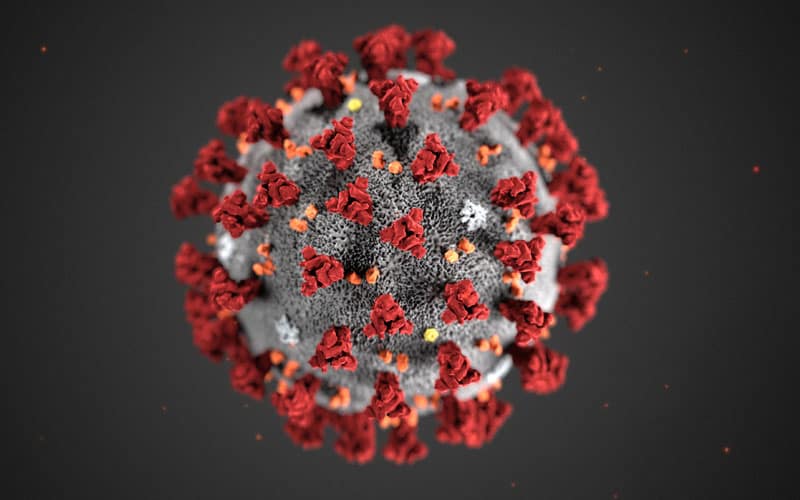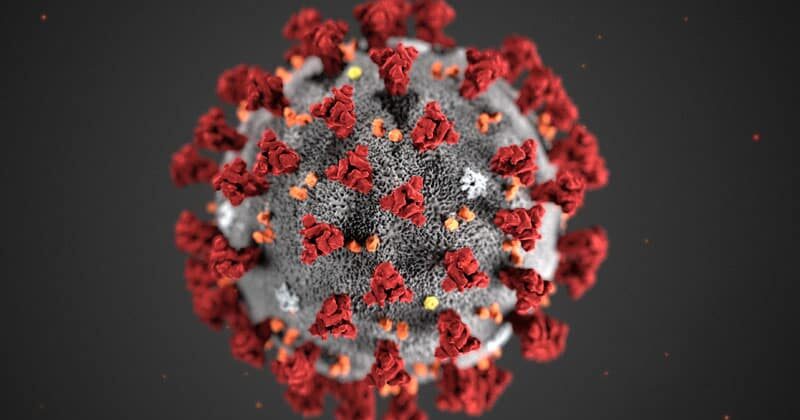RESEARCH
DISCOVERY
A Blog Devoted to UD Innovation, Excellence & Scholarship
COVID-19
COVID-19 research underway
The structure of the novel coronavirus that has caused the current global pandemic.
 UD’s Juan Perilla (far right) and Jodi Hadden-Perilla, working with a collaborator at Los Alamos National Laboratory, are leading a research team that is investigating the structure of the novel coronavirus that has caused the current global pandemic.
UD’s Juan Perilla (far right) and Jodi Hadden-Perilla, working with a collaborator at Los Alamos National Laboratory, are leading a research team that is investigating the structure of the novel coronavirus that has caused the current global pandemic.
Two University of Delaware researchers have been awarded a National Science Foundation (NSF) grant to study the novel coronavirus that causes COVID-19, using the kinds of high-tech supercomputing tools that previously led them to new insights into other viruses that harm human health.
Juan Perilla and Jodi Hadden-Perilla, both assistant professors in UD’s Department of Chemistry and Biochemistry, received the one-year, $200,000 grant this week through the NSF’s Rapid Response Research (RAPID) program. The NSF says RAPID proposals are used in cases of “severe urgency,” including quick responses to natural disasters.
The UD researchers are collaborating with investigator Tyler Reddy, also a computational virologist at Los Alamos National Laboratory, who has collaborated with them on previous studies.
The researchers will use computer simulations to analyze the molecular structure of the virus that has led to the current worldwide pandemic. Learning more about the structure “is now essential to provide understanding of viral entry and infection of human cells, a first step in developing novel drugs and vaccines to combat” the disease, Perilla and Hadden-Perilla wrote in a summary of their proposal.
“If you understand how something works, you can understand how to make it stop working,” Hadden-Perilla said of the need to analyze how the virus functions and how it infects people in order to disrupt it. “We need to know the atomistic structure so that researchers can determine ways to target it as they work to develop treatments and vaccines.”
Working remotely, using a robust infrastructure that connects them to their lab computers and supercomputing resources, the research team, which includes UD students, will focus on using supercomputers to perform molecular dynamics (MD) simulations at the atomic level.
MD simulations allow researchers to study the way molecules move in order to learn how they carry out their functions in nature. Computer simulations are the only method that can reveal the motion of molecular systems down to the atomic level and are sometimes referred to as the “computational microscope.”
Viruses aren’t static, Perilla noted, so simulations of the SARS-CoV-2 (the technical name of the virus) are key to understanding its components and functions.
The NSF grant provides the research team with time on the Frontera supercomputer at the Texas Advanced Computing Center at the University of Texas at Austin. Other COVID-19 researchers are also using Frontera, one of the most powerful supercomputers in the world, as part of the new public-private High Performance Computing Consortium formed to combat the virus.
In their grant application, Perilla and Hadden-Perilla said their team’s work could have an immediate impact on the pandemic. To enhance that potential, the researchers plan to disseminate their results “broadly and quickly,” they said, estimating that they could have the basics of their model — a first step in the process — in place within a few weeks.
“We have a lot of experience with this kind of research,” said Perilla, who has used molecular dynamics simulations to investigate other viruses in recent years.
He was part of a team that gained new insights into HIV, the virus that causes AIDS, by studying the capsid, the protein shell that encloses the viral genome, and its interactions with a specific protein. The research marked an important advance in better understanding the mechanism of HIV infection.
Perilla and Hadden-Perilla used similar high-tech tools to study the hepatitis B virus, again focusing on the structure of the capsid and how it moves, distorts and interacts with its environment. Those simulations were able to reveal a more complete picture of the capsid than studies done with experimental microscopes.






